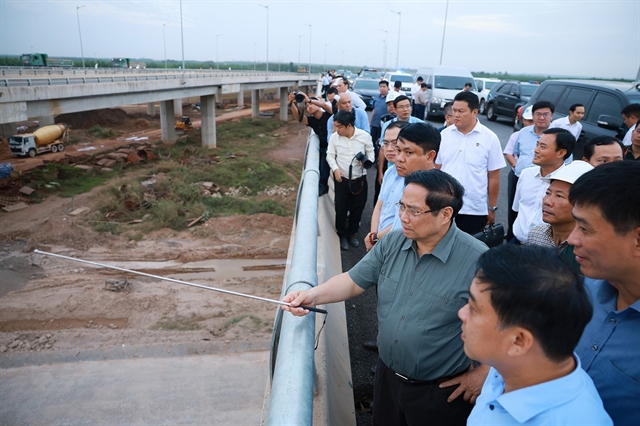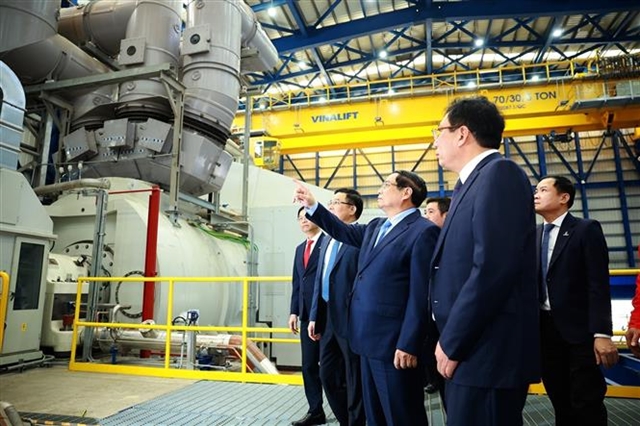 Society
Society

Until recently, growing grass to prevent soil erosion was beyond the imagination of many farmers in this northern mountainous region
by Chi Lan
YÊN BÁI — Growing grass to save land and prevent soil erosion was beyond the imagination of many farmers in this northern mountainous region until recently.
For many years, farmers in Vĩnh Kiên District - on the edge of Yên Bái and Tuyên Quang provinces - watched heavy rains wash away the soil of their farms, eroding the best soil layer for growing cassava. Many local households rely on cassava for their incomes, as well as on traditional rice paddy cultivation. And soil erosion has become much worse recently, as downpours grow more aggressive.
The separation between dry and rainy seasons has never been more blurred. “The weather has changed. Rains last September and October were just like May rains,” said Đặng Thị Hoa, a resident in Đồng Do Núi village.
“The soil eroded severely after all those rains,” she added, looking over her shoulder at a small gathering of dozens of farmers from different villages in the commune, standing at the foot of a bronze hill. They were there for a field-trip held by the International Centre for Tropical Agriculture (CIAT), to learn a new technique intended to help farmers protect their land from soil loss.
The technique is surprisingly simple. Residents just have to plant a few strips of paspalum grass - better known as ‘horse grass’ among the locals - like green stripes decorating the hills of cassava.
Yet, results are striking.
Trần Thị Nga, the leader of the field trip for Vĩnh Kiên farmers, manages to harvest nearly double the cassava she harvested before, since she started to grow grass with her cassava, instead of just growing cassava.
“I started growing the grass in 2002. Now I harvest 20 to 25 tonnes of cassava a year,” Nga said, "compared to the 15 tonnes of cassava per year which I used to harvest from the same hill" before horse grass became the new star in her Mười village in Văn Yên District, about 60km west of Vĩnh Kiên.
“In 2011, I even harvested 30 tonnes of cassava,” she said."Thanks to the grass, which magically holds back the soil when the rain falls down”, Nga added, pointing to a strip of grass growing on top of a land dyke more than one metre high.
Differences were clearly visible after just three or four years of growing the grass. Nga’s hill, and most of her neighbours’ hills, was transformed into a slope with horizontal green and bronze "steps" -- from a steep 45 degree incline.
Grass grown on the village head’s hectare of hill land turned out to have another positive effect: feed for her two farm animals. Nga did not have to bother growing grass for the water buffalo and cow anymore. Harvesting the horse grass was enough to feed both animals for the whole year.
“Cassava degrades soil fast. Couple that with unpredictable weather in recent years, and it became urgent that we find a way to make cassava production sustainable,” said Văn Yên Agricultural Extension Station deputy head Đoàn Mạnh Cường.
“Growing horse grass in strip patterns slows down rainwater flow, sustains soil fertility, and reduces the amount of fertilisers farmers must use. Horse grass cuts down production costs for farmers,” Cường said.
CIAT first introduced the horse grass strip technique in Nga’s Văn Yên Commune 14 years ago. It soon spread and became a hit with cassava-growing localities. From growing 1,000 hectares of cassava-with-grass-strips in 2002, local farmers now grow about 6,700 hectares in Văn Yên District, a seven-fold increase.
Success in Văn Yên inspired CIAT to help farmers elsewhere who are still struggling to adjust their traditional agricultural ways with weather which continues to grow ever harsher.
The grass strip technique was part of a bigger project by CIAT to provide farmers with agricultural technologies to enhance adaptability to climate change. Farming villages in Viet Nam and across Southeast Asia were targeted. The project was implemented simultaneously in three provinces, including Yên Bái, Nghệ An and Bạc Liêu.
“Cassava-grass strip farming is an example of climate change adaption technology,” said CIAT Director for Asia Dindo Campilan.
“What we are really doing is joining the hands and minds of farmers, researchers, and the local community. Solutions for agricultural problems caused by climate change come from everyone’s knowledge and expertise.”
After paying close attention to the grass-growing lesson, Hoa wants to plant horse grass on her cassava hills, too.
“I never heard of such a technique before. But now that I know, I will try it,” she said. — VNS




